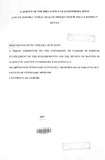| dc.description.abstract | Schistosomosis is caused by trematodes of the genus Schistosoma which are
widespread in Africa and affect both man and livestock. Schistosoma bovis is usually a
livestock parasite but may occasionally parasitise humans. Studies were carried out to
determine the prevalence of S. bovis in cattle and its possible public health importance in
Kwale District between the months of March and September 2005.
The study was done by carrying out abattoir surveys where the mesenteric veins of the
carcasses were visually examined for the presence of adult S. bovis worms. Three abattoirs
were visited which included Ngombeni and Kwale slaughter houses in Matuga division and
Mwambungo slaughter house in Msabweni division. Rectal faecal sample analysis for
identification of S. bovis eggs was carried out using the sedimentation technique. A total of
492 cattle faecal samples from various divisions in the district were examined.
Snail sampling was carried out in various water bodies using the scooping method. In
seasonal rivers, and during the dry season, snails were recovered by digging in riverbeds.
The snails that were recovered were put in 24-well micro titre plates and put under the shade
for at least two hours to induce shedding of cercariae from the snails.
Human stool samples from school children from Matuga Msabweni and Kinango
divisions were analyzed for S. bovis eggs using the Kato Katz technique and urine samples
were analyzed using the filtration technique. Records at Kwale KEMRl Laboratory were
examined for any recorded cases of S. bovis eggs in the last two years. To confirm the
identity of S. bovis adult worms, a polymerase chain reaction (peR) technique was used on
selected S. bovis adult worms from slaughtered cattle. A one way analysis of variance
(ANOV A) was used to compare the difference in frequencies of the number of animals
infected for the different sexes and age groups of the sampled animals and to check for any
significance of the differences in frequency of S bovis. A graphical presentation was used to
compare frequencies of S. bovis over the study period.
Rectal faecal sample analysis gave a point prevalence of S bovis eggs as 16.9%. The
age group ofless than 3 years and the age group of above 6 years gave a prevalence of
18.1% and 21.1 %, respectively and the difference in prevalence was not statistically
significant at 95 % confidence interval. The point prevalence of S bovis adult worms by
abattoir survey was 25.1 %. The incidence of S. bovis worms over the study period followed
the rainfall pattern and was highest in May, but lowest in September 2005.
Snails of the genus Bulinus, the intermediate hosts of S bovis were recovered from
the various water bodies in Kwale district. The snail population followed the rainfall pattern
being abundant during the wet months compared to the dry months. Cercarial shedding in
the micro titer plates were only recorded in September.
No S bovis eggs were recovered from the stool samples from school children but
other helminth parasites recovered included Trichuris trichuria and Ascaris lumbricoides
while, eggs of S. haematobium were recovered from three urine samples. Examination of
hospital records did not reveal any record of S. bovis eggs over the previous two years but
other parasites recorded over the same period were Plasmodium falciparum, S. haematobium,
T trichuria and A. lumbricoides. ,
Schistosoma bovis is prevalent in Kwale district as the polymerase chain reaction
(PCk) confirmed that the adult worms recovered from slaughtered cattle were S. bovis.
The snail intermediate hosts for S. bovis were present in Kwale District and the population
followed a rainfall pattern. Ova that resembled S. haematobium in shape but bigger than S. bovis and
S. haematobium in size were recovered from some rectal feacal samples. Further investigations may
be necessary to confirm their identity. | en |

